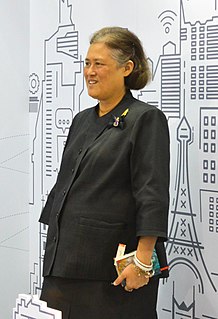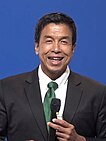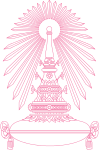Chulalongkorn University
 From Wikipedia - Reading time: 25 min
From Wikipedia - Reading time: 25 min
This article needs additional citations for verification. (August 2023) |
จุฬาลงกรณ์มหาวิทยาลัย | |
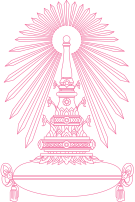 Phra Kiao, Chulalongkorn University Seal | |
Former names |
|
|---|---|
| Motto |
|
Motto in English |
|
| Type | Autonomous public university |
| Established | 26 March 1917 |
| Founder | King Vajiravudh |
Academic affiliation | ASAIHL, AUN, APRU, Washington University in St. Louis McDonnell International Scholars Academy[1] |
| Budget | 5,535 million baht (FY2019) |
| President | Wilert Puriwat |
| Students | 37,626[2] |
| Undergraduates | 26,202[2] |
| Postgraduates | 8,029[2] |
| 2,627[2] | |
| Location | , Thailand 13°44′18″N 100°31′56″E / 13.738359°N 100.532097°E |
| Campus | Downtown 2.0944 km2 (0.8087 sq mi) |
| Anthem | "Maha Chulalongkorn" ("Great Chulalongkorn") |
| Colours | Pink |
| Mascot | Samanea saman |
| Website | chula.ac.th chula.ac.th/en |
 | |
Chulalongkorn University (CU, Thai: จุฬาลงกรณ์มหาวิทยาลัย, RTGS: Chulalongkon Mahawitthayalai), nicknamed Chula (Thai: จุฬาฯ), is a public autonomous research university in Bangkok, Thailand. The university was originally founded during King Chulalongkorn's reign as a school for training royal pages and civil servants in 1899 (B.E. 2442) at the Grand Palace. It was later established as a national university in 1917, making it the oldest institute of higher education in Thailand.[3]
During the reign of Chulalongkorn's son, King Vajiravudh, the Royal Pages School became the Civil Service College of King Chulalongkorn. The Rockefeller Foundation[4] was instrumental in helping the college form its academic foundation.[5][6] On 26 March 1917, King Vajiravudh renamed the college "Chulalongkorn University".[7]
Chulalongkorn University is one of the National Research Universities and supported by the Office of Nation Education Standards and Quality Assessment of Thailand. Moreover, CU is the only Thai university which is a member of Association of Pacific Rim Universities (APRU).[8]
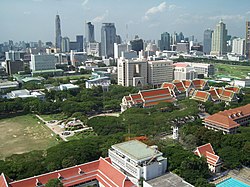
CU is composed of nineteen faculties, a School of Agriculture, three colleges, ten institutes and two other schools. Its campus occupies a vast area in downtown Bangkok. Graduates customarily receive their diplomas from the King of Thailand, a tradition begun by King Prajadhipok.
History
[edit]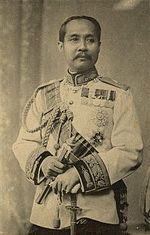

King Chulalongkorn's reforms, aimed at transforming Thailand into a modern state, demanded trained officials specialized in various fields. In 1899, the King founded the "Civil Service Training School"[9] near the north gate of the Grand Palace. Those who graduated from the school would become royal pages. As royal pages, they learned how to manage organizations by working closely with the king, which was a traditional way to enter the Siamese bureaucracy. After serving as royal pages, they would then serve in the Ministry of Interior or other government ministries.
On 1 April 1902, the King renamed the school. It became the "Royal Pages School" (Thai: โรงเรียนมหาดเล็ก).[10] On 1 January 1911, King Vajiravudh changed the name to "Civil Service College of King Chulalongkorn" (Thai: โรงเรียนข้าราชการพลเรือนของพระบาทสมเด็จพระจุลจอมเกล้าเจ้าอยู่หัว) as a memorial to his father and moved the school to Windsor Palace in the Pathumwan District.[11]
The King subsidized the construction of a university campus and organized various schools around the city into Chulalongkorn. The college offered eight majors taught by five schools including;
- School of International Relations in the Royal Palace
- School of Teacher Training at Baan Somdet Chao Phraya
- Royal Medical College at Siriraj Hospital
- School of Legal Studies
- School of Mechanical Sciences at Windsor Palace

King Rama VI realized that education should be provided not only to bureaucrats, but to all people. On 26 March 1917, the college was upgraded to "Chulalongkorn University" (Thai: จุฬาลงกรณ์มหาวิทยาลัย),[12] and the schools were transformed into four faculties: Faculty of Arts and Sciences, Faculty of Public Administration, Faculty of Engineering, and Faculty of Medicine.
The Rockefeller Foundation reorganized the curriculum of the Faculty of Medicine. In 1923, the Faculty of Medicine became the first faculty to accept secondary school (Mattayom) graduates. The remaining faculties then followed suit. After the 1932 Revolution, the People's Party wanted legal and political studies to be independent of "royalists" so they moved the Faculty of Law and Political Science to the new Thammasat University in 1933.
In 1938, Chulalongkorn University's Preparatory School was founded to provide pre-collegiate education to students. Those who managed to enter the university had to spend two years in the Preparatory School before going on to the Faculty of Arts and Sciences. The Preparatory School, however, ceased to be a university-owned preparatory school in 1947 and became the independent Triam Udom Suksa School. Later, the university established Chulalongkorn University Demonstration School (CUD) as a laboratory school for primary and secondary education for the Faculty of Education.
Symbols
[edit]Phra Kiao
[edit]
Since the establishment of the Royal Pages School, the former name of the university, King Chulalongkorn authorized the use of his personal emblem as a school emblem.[13] The emblem is called Phra Kiao, a Thai coronet, royal headgear for young princes and princesses. As the school was transformed into the university, the King authorized the use of phra kiao. Today, phra kiao appears not only in formal letters and transcripts, but also on souvenirs made by the university as well as student uniforms.
Student uniform
[edit]Undergraduates are required to wear a uniform when studying, taking examinations, or contacting the university in person. Male graduate students wear a collared or polo shirt and dark trousers. Women wear a plain blouse with long skirt.
Originally, the university uniform was adapted from a uniform worn by Chulalongkorn's heirs.[14] The uniform was later updated, but the original is reserved as a formal uniform. The formal uniform is usually worn by student leaders and graduates.
Today, the ordinary uniform for male undergraduate students consists of a plain white shirt with long or short sleeves and black (or dark blue) trousers. Wearing a dark blue necktie with colored phra kiao engraved on its front is mandatory for first-year students but optional for higher years. However, a black tie with a silver phra kiao pin is usually used by upperclass student in some faculties. Female students are required to wear a short-sleeved blouse with a fold along the spine. The buttons must be made of metal, and a small phra kiao emblem must be pinned on the right breast. A dark blue or black pleated skirt with any black, white, or brown shoes are worn. For female first-year students, white leather shoes are mandatory.[15] Chulalongkorn University's uniforms have long been the template of many uniforms used in other universities in Thailand.
Academic dress
[edit]The academic dress of Chulalongkorn University is based on ceremonial attire called khrui, a gown made from very fine mesh. The robe was originally reserved for pre-ordination monks, ministers and royal family members. Like dresses worn in the United Kingdom, the robe is open-fronted and calf-length. Cap and hood, however, are omitted. The gown is faced and lined with a felt strip dyed according to the status of the wearer and decorated with gold ribbons. The elbow and wrist portion of the gown is also wrapped with the same felt strip.
Bachelor's and master's gown is faced and bordered with a black felt strip, while a doctor's gown uses a scarlet felt strip. This colour scheme is similar to one used at the University of Oxford: Black for bachelors and masters (and doctors in undress); Scarlet for doctors (in full-dress).[16] The cord (bachelor) or ribbon (master and doctor) dyed with the faculty colour is attached to the centre of the felt strip longitudinally.[17] Officers' (lecturers, university council members, vice-chancellor and chancellor) gown is faced with a pink strip and centred with a gold thread, regardless of the faculty. The specially designed gown with a yellow facing is reserved for the king of Thailand, who is also Visitor to the University.[18]
Vajiravudh authorized the university to use the traditional Thai gown instead of the western one,[19] but the regulation on this matter was enacted in 1930 by Prajadhipok.[20]
Example of felt strips
[edit]-
Visitor to the University's robe
-
Officer's robe
-
Faculty of Science BSc
-
Faculty of Science MSc or MRes
-
Faculty of Science PhD
-
Faculty of Commerce and Accountancy B.Acc.
-
Faculty of Commerce and Accountancy MAcc
-
Faculty of Commerce and Accountancy DCom
Rain Trees
[edit]
Rain trees are common on the university campus. They are associated with the cycle of student life. Fresh green leaves at beginning of the term represent the freshmen's naivete. As the tree produces slimy pods and sheds leaves, the ground beneath it becomes slippery, thus alerting students to prepare for examinations. If they walk carefully, they will not slip (pass examinations). If they walk heedlessly, they will slip and fall (fail examinations).[21]
From 1937–1957, many rain trees were cut down to free space for new buildings. King Bhumibol Adulyadej noticed the dramatic decrease in the number of rain trees. On 15 January 1962, he brought five trees from Hua Hin and planted them in front of the university auditorium, proclaiming: "...I give these five trees as an eternal memorial." (Thai: จึงขอฝากต้นไม้ไว้ห้าต้นให้เป็นเครื่องเตือนใจตลอดกาล).
Organization
[edit]



Chulalongkorn University consists of 19 faculties, three colleges, one school and many institutes which function as teaching and research units.[22][23]
In 1917, the university had four faculties: Arts and Sciences, Public Administration, Engineering, and Medicine. The Faculty of Law was established in 1933 as part of the Faculty of Law and Political Science.[24] From the 1930s to the 1950s it expanded to various fields including Pharmacy (1934), Veterinary Science (1935), Architecture (1939), Dentistry (1940), and Commerce and Accountancy (1943). In 1943, the regency government under General Phibun separated the Faculty of Medicine, Dentistry, Pharmacy, and Veterinary Science to become the University of Medical Sciences, now Mahidol University. In 1948, the Faculty of Political Science was re-established. The Faculty of Education was established in 1957 from the School of Teacher Training at Baan Somdet Chao Phraya (Thai: โรงเรียนฝึกหัดครู บ้านสมเด็จเจ้าพระยา).[25] In 1967, the Faculty of Veterinary Science was returned from Kasetsart University and the Faculty of Medicine at Chulalongkorn Hospital was moved from University of Medical Sciences to Chulalongkorn University. In 1972, the Faculty of Dentistry and Faculty of Pharmacy were reinstated.
The Office of the Commission on Agricultural Resource Education (OCARE) was established in 2009.[26] It is not an administrative office, but a school in which teaching and research are carried out. It admits students from two groups: one from northern Thai provinces (Nan, Phayao, Phrae, Uttaradit) and another from the rest of country. It was upgraded to the School of Agricultural Resources with full degree-granting power on 5 March 2014.[23] In 2014 it became the School of Agriculture, Chulalongkorn University (SAR).
In 2019, aiming to address global industry changes and demand for relevant education, Chulalongkorn University launched Chulalongkorn School of Integrated Innovation (ScII) to offer the first in Asia interdisciplinary undergraduate degree in both arts and science - Bachelor of Arts and Science in Integrated Innovation (BAScii).[27]

Health sciences
[edit]- Faculty of Allied Health Sciences
- Faculty of Dentistry
- Faculty of Medicine
- Faculty of Nursing
- Faculty of Pharmaceutical Sciences
- Faculty of Psychology
- Faculty of Sport Sciences
- Faculty of Veterinary Science
Science and technology
[edit]- Faculty of Architecture
- Faculty of Engineering
- Faculty of Science
- School of Agricultural Resources
Social science and humanities
[edit]- Faculty of Commerce and Accountancy (Also known as Chulalongkorn Business School)
- Faculty of Arts (Letters)
- Faculty of Communication Arts
- Faculty of Economics
- Faculty of Education
- Faculty of Fine and Applied Arts (Art)
- Faculty of Law
- Faculty of Political Science
Integrated Faculty
[edit]International programs
[edit]
CU's international programs offers 99 international programs, including 17 Bachelor, 48 Master and 34 Doctoral programs. Admissions for international students are based on the guidelines issued by the Council of University Presidents of Thailand.
Bachelor's Degrees:
- Chula International School of Engineering
- Faculty of Science
- Faculty of Architecture - International Program of Design and Architecture -INDA- and CommDe
- School of Integrated Innovation - Bachelor of Arts and Science in Integrated Innovation (BAScii)
- Chulalongkorn Business School - The Bachelor of Business Administration
- Faculty of Architecture
- Faculty of Communication Arts
- Faculty of Economics
- Faculty of Arts
- Faculty of Political Science
- Faculty of Psychology
Graduate institutes
[edit]- College of Population Studies
- College of Public Health Science
- Graduate School
- Language Institute
- Petroleum and Petrochemical College
- Sasin School of Management
Research institutes
[edit]- Aquatic Resources Research Institute
- Energy Research Institute
- Environmental Research Institute
- Institute of Asian Studies
- Institute of Biotechnology and Genetic Engineering
- Metallurgy and Materials Science Research Institute
- Social Research Institute
- Transportation Institute
Associated institutes
[edit]- Police Nursing College
- Red Cross College of Nursing
Research
[edit]Chulalongkorn University has research organizations in many fields of study.
- Aquatic Resources Research Institute
- Energy Research Institute
- Environment Research Institute
- Social Research Institute
- The Institute of Biotechnology and Genetics Engineering
- Metallurgy and Material Science Research Institute
- Institute of Asian Studies
- Transportation Institute
Rankings
[edit]| University rankings | |
|---|---|
| Global – Overall | |
| ARWU World[29] | 501–600 (2023) |
| QS World[30] | 211 (2024) |
| THE World[31] | 601–800 (2024) |
| USNWR Global[32] | =547 (2023) |
Overall
[edit]- In the QS Asia University Rankings 2016. Chulalongkorn has been ranked as the top Thai university and 45th in Asia[33]
- In the QS World University Rankings 2017/18. Chulalongkorn is ranked the 1st in Thailand and 245th in the world[34][35]
- In the QS graduate employability rankings 2016. Chulalongkorn is No. 1 university in Thailand and No. 151 - 200 in the world
- In the Center for World University Ranking or CWUR, Chulalongkorn is ranked as number 1 university in Thailand and 308th in world rankings in 2017, considered by alumni, researches, quality of curriculums and instructors.[36]
- In the Round University Ranking 2017. Chulalongkorn is ranked the 1st in Thailand and ranked 398th in the world.[37]
- In the RUR Research Performance World University Rankings 2016. Chulalongkorn is No. 1 university in Thailand and No. 424 in the world
- In the CWTS Leiden Ranking 2016. Chulalongkorn is ranked the first in Thailand and 432nd in the world.[38]
- In the THE World University Rankings 2016. Chulalongkorn is ranked 601–800 in the world.[39]
- In the RUR Reputation Rankings 2016. Chulalongkorn is No. 1 university in Thailand and No. 182 in the world.[40]
- In the SCImago institutions Ranking, which ranks international researches of universities. Chulalongkorn is ranked 475th in World rankings in 2016, up six places from last year.[41]
- In the Academic Ranking of World Universities 2017. Chulalongkorn is No. 1 university in Thailand and No. 401-500 in the world.[42]
- In the Nature Index, the affiliations of high-quality scientific articles. Chulalongkorn is ranked the 1st in Thailand in 2016.[43]
- US News ranked Chulalongkorn 522th in the world.[44] based on the university's reputation, medium, citations, international cooperation, and he quantity of PhD students.
- In the 2018 Times Higher Education Emerging Economies Index, Chula ranked 126.[45]
- In the UI Green Metric-City Center, Chulalongkorn was ranked the 1st in national rankings and the 15th in world rankings.[46] considered by Setting and Infrastructure, Energy and Climate Change, Waste, Water, Transportation and Education.
- The Webometric ranking indicates quantity and quality of the university's medium, considered by being searched by search engines, online documents, and citations in Google Scholar. Chulalongkorn is ranked the 1st in national rankings 548th in the world.[47]
Subject
[edit]QS World University Rankings by Subject 2024: Chula ranked number one in Thailand in 32 disciplines[48]
| World rank | Subject |
|---|---|
| 51 – 100 |
|
| 101 – 150 |
|
| 151 – 200 |
|
| 201 – 250 |
|
| 251 – 300 |
|
| 301 – 400 |
|
Scholarships
[edit]Research scholarships
[edit]- The 90th Anniversary of Chulalongkorn University Scholarship
- CU.Graduate School Thesis Grant
- Overseas Research Experience Scholarship for Graduate Student
- Overseas Academic Presentation Scholarship for Graduate Students
- Overseas Academic Presentation Scholarship Option II for Graduate Student's and Postdoctoral Fellow's Publication
- Domestic Academic Presentation Scholarship for Graduate Student
- Postdoctoral Fellowship
Education scholarships
[edit]- The 100th Anniversary Chulalongkorn University for Doctoral Scholarship
- H.M. King Bhumibhol Adulyadej's 72nd Birthday Anniversary Scholarship
- Thainess Study Scholarship for Graduate Students
- 60/40 Support for Tuition Fee
- Teaching Assistant Scholarship
- Research Assistant Scholarship
- Tuition fees Scholarship for Master to Doctoral
- ASEAN Scholarship
- Scholarship for International Graduate Students
Campus
[edit]
The university campus occupies an area of 637 rai (101.9 ha; 252 acres) in the downtown Pathum Wan District. It accounts for just over half of the 1,153 rai (184.5 ha; 456 acres) of land owned by the university, the rest of which is commercially developed by the university's Property Management Office or used by other institutions.
Centenary Park
[edit]The west side of Chula's campus is the site of this innovative park. It has gradually sloping portions.[49] Its 28 rai expanse contains a water retention pond with a capacity of 3.8 million liters and a rain garden. Both help to ameliorate Bangkok's seasonal flooding. It was built to commemorate Chula's 100th anniversary in 2017.[50]
Accommodation
[edit]Chulalongkorn University International House (CU iHouse)[51] is a 26-storey, 846-unit, on campus residence for international students and lecturers. Rooms come fully furnished with air conditioning, modern conveniences, 24-hour security and safety systems. The residence is included in the university's shuttle bus services.
Honorary degrees
[edit]The university has bestowed honorary degrees on heads of state and other international dignitaries, including two U.S. presidents:
- Lyndon B. Johnson, October 29, 1966[52]
- Bill Clinton, November 26, 1996[53]
- Nelson Mandela, July 17, 1997[54]
Traditions
[edit]Chulalongkorn University student traditions include:
- Chula–Thammasat Traditional Football Match: The annual football match between Chulalongkorn University and Thammasat University in January at Suphashalasai Stadium. It first started in 1934.
- Loy Krathong: an annual celebration of the full moon night, which usually falls on the first full moon day in November. Since the festival is open to the public, it attracts many people, especially Chulalongkorn students and faculty and those who live in downtown Bangkok, to come to the university to float their krathongs on the university's pond.
- Chulalongkorn Academic Exhibition: a triennial academic and research exhibition presented by Chulalongkorn University's students and faculty. It is regarded as one of the most important academic fairs in Thailand.
Student activities and clubs
[edit]The university is host to 40 student clubs, including the Buddhism and Traditions Club, the Religious Studies Club, the Mind Study Club, and the Thai Classical Music Club. Chulalongkorn also has a Morals Network, which actively campaigns to protect student activities from damaging the university's reputation. The university's Cheer Club annually organizes the Chula-Thammasat traditional football match.
Notable alumni
[edit]- Princess Maha Chakri Sirindhorn, Princess of Thailand
- Princess Sirivannavari Nariratana Rajakanya, Princess of Thailand
- Thawan Thamrongnawasawat, 8th Prime Minister of Thailand
- Paetongtarn Shinawatra, 31th Prime Minister of Thailand
- Wan Muhamad Noor Matha, Thai politician, Speaker of the House of Representatives and President of the National Assembly of Thailand
- Padipat Suntiphada, the First Deputy Speaker of the House of Representatives of Thailand
- Pornpetch Wichitcholchai, President of the Senate of Thailand
- Surakiart Sathirathai, Deputy Prime Minister, Minister of Foreign Affairs, Thailand's candidate for United Nations Secretary-General
- Kittiratt Na-Ranong, Deputy Prime Minister, Minister of Finance
- Parnpree Bahiddha-nukara, Deputy Prime Minister, Minister of Foreign Affairs
- Niwatthamrong Boonsongpaisan, Deputy Prime Minister, Minister of Commerce
- Phumtham Wechayachai, Deputy Prime Minister, Minister of Commerce
- Mingkwan Saengsuwan, Deputy Prime Minister, Minister of Commerce
- Kosit Panpiemras, Deputy Prime Minister, Minister of Industry
- Yongyuth Wichaidit, Deputy Prime Minister, Minister of Interior
- Sudarat Keyuraphan, Thai politician, Minister of Public Health
- Chaikasem Nitisiri, Thai politician, Minister of Justice
- Kalaya Sophonpanich, Thai politician and physicist, Minister of Science and Technology
- Anek Laothamatas, Thai political scientist, Minister of Higher Education, Science, Research and Innovation
- Jakrapob Penkair, Minister to the Office of the Prime Minister
- Tiang Sirikhanth, Minister, leader of The Free Thai Movement
- Chaithawat Tulathon, Thai politician, Leader of the Opposition, Leader of the Move Forward Party
- Natthaphong Ruengpanyawut, Thai politician, Leader of the Opposition, Leader of the People's Party
- Chadchart Sittipunt, Thai politician, Governor of Bangkok
- Bhichit Rattakul, Thai politician, former Governor of Bangkok
- Thanathorn Juangroongruangkit, Thai politician, businessman, Leader of the Future Forward Party
- Chit Phumisak, Thai Marxist historian, activist, author, philologist, poet, songwriter, and communist revolutionary
- Boonsanong Punyodyana, Thai politician, general secretary of the Socialist Party of Thailand
- Boonlua Debyasuvarn, Thai writer, educator and civil servant
- Kitti Thonglongya, Thai ornithologist and mammalogist
- Prince Subhadradis Diskul, Thai archaeologist, historian
- Nidhi Eoseewong, Thai historian, Fukuoka Asian Culture Prize
- Therdchai Jivacate, Thai orthopedic surgeon and inventor, Ramon Magsaysay Award
- Nilawan Pintong, Thai feminist, Ramon Magsaysay Award
- Panipak Wongpattanakit, Thai taekwondo athlete, Gold medal Women's taekwondo at the 2020 Summer Olympics, 2024 Summer Olympics
- Tawin Hanprab, Silver medal Men's taekwondo at the 2016 Summer Olympics
- Chanatip Sonkham, Bronze medal Men's taekwondo at the 2012 Summer Olympics
- Sapsiree Taerattanachai, Thai badminton player, Gold medal 2021 World Championships
- Dhasanawalaya Sornsongkram, daughter of Princess Galyani Vadhana
- Pinyo Suwankiri, Thailand National Artist (Thai architecture)
- Anchalee Vivatanachai, Thai writer, winner of the S.E.A. Write Award
- Chiranan Pitpreecha, Thai writer, winner of the S.E.A. Write Award
- Binlah Sonkalagiri, Thai writer, winner of the S.E.A. Write Award
- Win Lyovarin, Thai writer, winner of the S.E.A. Write Award
- Yong Poovorawan, Thai scientist, professor of pediatrics
- Pornanong Aramwit, Pharmaceutical scientist, pharmacist and academic
- Prasarn Trairatvorakul, Thai banker, former governor of Bank of Thailand.
- Phanya Nirunkul, Thai Businessman and TV presenter
- Banjong Pisanthanakun, Thai filmmaker and screenwriter
- Nawapol Thamrongrattanarit, Thai writer, screenwriter and film director
- Artiwara Kongmalai, Thai rock music singer and vocalist
- Violette Wautier, Thai singer, songwriter and actress
- Alexander Rendell, Thai actor and model
- Chaiyapol Julien Poupart, Thai actor and model
- Chutavuth Pattarakampol, Thai actor and model
- Pakorn Chatborirak, Thai actor and model
- Tawan Vihokratana, Thai actor and model
- Thitipoom Techaapaikhun, Thai actor
- Natapohn Tameeruks, Thai actor and model
- Urassaya Sperbund, Thai actress and model
- Taksaorn Paksukcharern, Thai actress and model
- Pimprapa Tangprabhaporn, Thai actress and model
- Sutatta Udomsilp, Thai actress
- Pachara Chirathivat, Thai actor and TV presenter
- Suppasit Jongcheveevat, Thai actor and model
- Waruntorn Paonil, Thai actress and singer
- Tontawan Tantivejakul, Thai actress and model
International reputation
[edit]- The PH21 team, Computer Engineering students at Chulalongkorn University, got the 1st prize from the Microsoft Imagine Cup 2016 in the games category[55]
- Chulalongkorn University Concert Choir Won Gold Award in World-Class Musical Competition 2014[56][57]
Robocup competitions
[edit]The university RoboCup team, Plasma‐Z, got several prizes from the robotics competition as follow.[58]
- In 2005, almost reached the quarter-final at Osaka RoboCup.
- In 2006, the third place and technical challenge at Bremen RoboCup.
- In 2007, second place Atlanta World RoboCup.
- In 2008, finally, the team got champion of World RoboCup Small‐Sized Robot League at Suzhou, China.
Moreover, another university Robocup team, Plasma-RX has participated in Rescue robot league at World RoboCup 2008, Suzhou, China, and won the first prize and the best-in-class in mobility award.[59][60]
See also
[edit]- Academic dress of Chulalongkorn University
- Sasin Graduate Institute of Business Administration of Chulalongkorn University
- Education in Thailand
- Chula United football club
- Education for Liberation of Siam
References
[edit]- ^ "McDonnell International Scholars Academy".
- ^ a b c d Office of the Registrar, Chulalongkorn University. Statistics on Students in Different Level Archived December 1, 2017, at the Wayback Machine. Last updated May 21, 2018
- ^ "CU History". Archived from the original on October 8, 2016. Retrieved September 28, 2016.
- ^ Becker, William H. Innovative Partners The Rockefeller Foundation and Thailand. New York: The Rockefeller Foundation, 2013. William H. Becker. "Assets: Rockefeller Foundation" Rockefeller Foundation. 2013. https://assets.rockefellerfoundation.org/app/uploads/20131001203515/Innovative-Partners.pdf Archived December 20, 2016, at the Wayback Machine (29 November 2106).
- ^ "CU History". Archived from the original on October 8, 2016. Retrieved December 10, 2016.
- ^ "Thailand's 'Father of Modern Medicine'". News. January 23, 2014. Retrieved December 10, 2016.
- ^ Chulalongkorn University official website. CU History Archived October 8, 2016, at the Wayback Machine. Retrieved January 15, 2016.
- ^ "Association of Pacific Rim Universities - Member Universities". apru.org. Archived from the original on September 4, 2017. Retrieved September 19, 2017.
- ^ Thai: โรงเรียนสำหรับฝึกหัดวิชาข้าราชการฝ่ายพลเรือน
- ^ ราชกิจจานุเบกษา, พระบรมราชโองการประกาศตั้งโรงเรียนมหาดเล็ก. เล่ม ๑๙, ตอน ๑, ๖ เมษายน พ.ศ.๒๔๔๕, หน้า ๑๖ (Royal Order to establish Royal Page School)
- ^ ราชกิจจานุเบกษา, พระบรมราชโองการประกาศตั้งโรงเรียนข้าราชการพลเรือนฯ , เล่ม ๒๗, ตอน ก, ๑๑ มกราคม พ.ศ.๒๔๕๔, หน้า ๑๒๓ (Royal Order to establish the Civil Service College of King Chulalongkorn)
- ^ ราชกิจจานุเบกษา, พระบรมราชโองการ ประกาศประดิษฐานโรงเรียนข้าราชการพลเรือนของพระบาทสมเด็จพระจุลจอมเกล้าเจ้าอยู่หัวขึ้นเป็นโรงเรียนข้าราชการพลเรือน, เล่ม ๒๗, ตอน ก, ๑๕ เมษายน พ.ศ.๒๔๖๐ (ประกาศเมื่อวันที่ ๒๖ มีนาคม พ.ศ.๒๔๖๐, หน้า ๑๒๓ (Royal Order to establish the Civil Service College of King Chulalongkorn.)
- ^ About Phra Kiao by Chulalongkorn Memorial Hall Archived June 7, 2011, at the Wayback Machine
- ^ History about CU uniform. Archived 20 May 2010 at the Wayback Machine
- ^ ราชกิจจานุเบกษา, ข้อบังคับจุฬาฯ ว่าด้วยเครื่องแบบ เครื่องหมาย และเครื่องแต่งกายนิสิต พ.ศ.๒๕๕๓, เล่ม ๑๒๗, ตอนพิเศษ ๕๒ ง, ๒๖ เมษายน พ.ศ.๒๕๕๓ (The university regulation on uniform and dress codes, 2010)
- ^ Shaw, G. W. (1995) Academical Dress of British and Irish Universities, Chichester: Philmore & Co. Ltd, ISBN 0-85033-974-X
- ^ ราชกิจจานุเบกษา.ข้อบังคับจุฬาฯ ว่าด้วยการกำหนดปริญญาในสาขาวิชา อักษรย่อสำหรับสาขาวิชา ครุยวิทยฐานะ เข็มวิทยฐานะ และครุยประจำตำแหน่ง พ.ศ.๒๕๕๓.เล่ม ๑๒๗ ตอนพิเศษ ๕๒ ง, ๒๖ เมษายน ๒๕๕๓. (University Regulation on Degrees Granted, Graduation and Faculty Gowns, 2010)
- ^ ราชกิจจานุเบกษา.พระราชกำหนดเสื้อครุยบัณฑิตของจุฬาลงกรณ์มหาวิทยาลัย พ.ศ.๒๔๗๓. เล่ม ๔๗, ๖ กรกฎาคม ๒๔๗๓. (Regulation on Chulalongkorn University Graduation Gown, 1930)
- ^ Graduation Gown of Chulalongkorn University Archived May 10, 2011, at the Wayback Machine
- ^ ราชกิจจานุเบกษา, พระราชกำหนดเสื้อครุยบัณฑิตของจุฬาลงกรณมหาวิทยาลัย พ.ศ.๒๔๗๓, เล่ม ๔๗ หน้า ๙๒-๙๖ (Academic dress act 1930)
- ^ Rain Tree-The Symbol of Chulalongkorn University Archived June 7, 2011, at the Wayback Machine
- ^ ราชกิจจานุเบกษา, ประกาศจุฬาลงกรณ์มหาวิทยาลัย เรื่อง ส่วนงานของมหาวิทยาลัย พ.ศ. ๒๕๕๒, เล่ม ๑๒๗, ตอนพิเศษ ๑๖ ง, ๑ กุมภาพันธ์ พ.ศ. ๒๕๕๓, หน้า ๗๐ (University notification (rather command) on academic units, 2008)
- ^ a b ราชกิจจานุเบกษา, ประกาศจุฬาลงกรณ์มหาวิทยาลัย เรื่อง ส่วนงานของมหาวิทยาลัย (ฉบับที่ ๒) พ.ศ. ๒๕๕๗, เล่ม ๑๓๑, ตอนพิเศษ ๔๙ ง, ๑๘ มีนาคม พ.ศ. ๒๕๕๗, หน้า ๓ (Amendment to 2008 regulation, ratified 2014)
- ^ www.law.chula.ac.th Archived August 29, 2011, at the Wayback Machine
- ^ Faculty of Education, Chulalongkorn University Archived September 4, 2011, at the Wayback Machine
- ^ Principles and history of establishing OCARE. Archived March 5, 2011, at the Wayback Machine
- ^ "Chula Opens School of Integrated Innovation (ScII)". Chulalongkorn University. Retrieved October 14, 2021.
- ^ "Chula Opens School of Integrated Innovation (ScII)". Chulalongkorn University. Retrieved February 9, 2020.
- ^ [Academic Ranking of World Universities 2023: https://www.shanghairanking.com/institution/chulalongkorn-university%7Cdate=15 August 2023]
- ^ [QS World University Rankings: Chulalongkorn University https://www.topuniversities.com/universities/chulalongkorn-university]
- ^ "Chulalongkorn University". March 3, 2024.
- ^ [1]
- ^ "QS University Rankings: Asia 2016". June 8, 2016. Retrieved September 16, 2016.
- ^ "QS World University Rankings 2016". August 25, 2016. Retrieved September 16, 2016.
- ^ "Chulalongkorn University". Top Universities. July 16, 2015. Retrieved June 7, 2017.
- ^ "CWUR 2017 | Top Universities in Thailand". cwur.org. Retrieved September 16, 2016.
- ^ "RANKINGS". roundranking.com. Retrieved September 16, 2016.
- ^ (CWTS), Centre for Science and Technology Studies. "CWTS Leiden Ranking 2016". CWTS Leiden Ranking 2016. Retrieved September 16, 2016.
- ^ "World University Rankings". September 30, 2015. Retrieved September 16, 2016.
- ^ "Reputation Rankings". roundranking.com. Retrieved December 20, 2016.
- ^ "Scimago Institutions Rankings". scimagoir.com. Retrieved September 16, 2016.
- ^ "World University Rankings - 2017 | Thailand Universities in Top 500 universities | Academic Ranking of World Universities - 2017 | Shanghai Ranking - 2017". shanghairanking.com. Archived from the original on January 24, 2021. Retrieved August 15, 2017.
- ^ "2016 tables: Institutions | 2016 tables | Institutions | Nature Index". natureindex.com. Retrieved September 16, 2016.
- ^ "Top World University Rankings | US News Best Global Universities". Archived from the original on August 19, 2013. Retrieved November 2, 2019.
- ^ "Chula falls to 126th in Times uni ranking". Bangkok Post. May 10, 2018. Retrieved November 5, 2018.
- ^ "Ranking By Campus Setting – City Center 2016 | Greenmetric UI". greenmetric.ui.ac.id. Archived from the original on April 21, 2017. Retrieved February 1, 2017.
- ^ "Thailand | Ranking Web of Universities". webometrics.info. Retrieved February 1, 2017.
- ^ "Chula Ranks No.1 in Thailand for 32 Subjects in the QS World University Rankings by Subject 2024". chula.ac.th. Retrieved July 27, 2024.
- ^ "A secret weapon from Thailand that can change the future of Mumbai - Sinking future".
- ^ Ocharoenchai, Nanticha (November 19, 2018). "Seeing green is believing". Bangkok Post. Retrieved November 20, 2018.
- ^ "CU iHOUSE". PMCU (in Thai). Retrieved February 9, 2020.
- ^ "President Johnson received an Honorary Doctorate in Political Science from Chulalongkorn University. | U.S. Embassy & Consulate in Thailand". U.S. Embassy & Consulate in Thailand. Retrieved December 10, 2016.
- ^ "William J. Clinton: Remarks at Chulalongkorn University in Bangkok". presidency.ucsb.edu. Retrieved December 10, 2016.
- ^ "Nelson Mandela Centre of Memory". Db.nelsonmandela.org. Retrieved May 20, 2013.
- ^ "Games, Innovation and World Citizenship winners announced in Microsoft Imagine Cup, setting stage for Friday's World Championship - The Fire Hose". July 28, 2016. Retrieved September 18, 2016.
- ^ "Chulalongkorn University Concert Choir Won Gold Award in World-Class Musical Competition". Retrieved September 18, 2016.
- ^ "This Imagine Cup team gives you the power to manipulate time and see the future". Microsoft Imagine Blog. Retrieved December 10, 2016.
- ^ PlasmaZ Extended Team Description Paper[permanent dead link]
- ^ Chuengsatiansup, K.; Sajjapongse, K.; Kruapraditsiri, P.; Chanma, C.; Termthanasombat, N.; Suttasupa, Y.; Sattaratnamai, S.; Pongkaew, E.; Udsatid, P.; Hattha, B.; Wibulpolprasert, P.; Usaphapanus, P.; Tulyanon, N.; Wongsaisuwan, M.; Wannasuphoprasit, W.; Chongstitvatana, P. (2009). "Plasma-RX: Autonomous Rescue robots". 2008 IEEE International Conference on Robotics and Biomimetics. pp. 1986–1990. doi:10.1109/ROBIO.2009.4913305. ISBN 978-1-4244-2678-2. S2CID 15839311.
- ^ Plasma-RX: Autonomous Rescue Robots
 KSF
KSF








